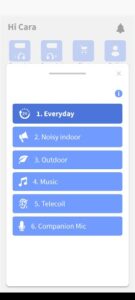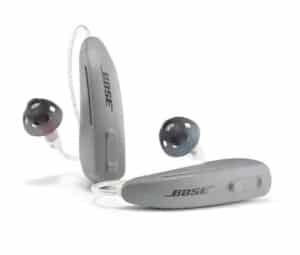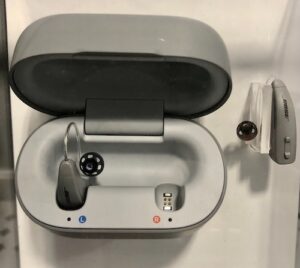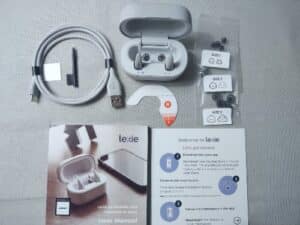- Cost per pair: $799
- Dimensions: 1.5 inches long
- Weight: 4 grams (gm)
- Type of hearing aid: Behind-the-ear (BTE)
- Color options: Gray, beige, bronze, silver, or metallic black
- Degree of hearing loss: Mild to moderate
- Rechargeable battery? No
- Bluetooth Streaming? No
Lexie Hearing Aids Review 2025: Are These Self-Fitting Hearing Aids Right for You?
Key Takeaways
- At less than $1,000 per pair, Lexie hearing aids may be a more affordable solution for adults 18 and older with mild to moderate hearing loss.
- Like other over-the-counter (OTC) hearing aids, Lexie devices can be purchased without a hearing exam, prescription, or fitting appointment.
- Lexie hearing aids offer multiple features, such as advanced technology, rechargeability, a smartphone app, and ongoing professional support.
- At $799 per pair, the Lexie Lumen and B1 stand out as the company’s most affordable options. Despite the budget price, these models still pack helpful features like six preset listening environments, telecoil connectivity, and an easy-to-use mobile app.
- Our team likes Lexie for its combination of advanced technology, knowledgeable support, and budget-friendly pricing. Drawbacks include a lack of Bluetooth music streaming, shorter battery life compared to some other brands, and adjustments through the Lexie mobile app only.
Many people with hearing issues don’t seek treatment for an average of 10 years after they start noticing problems, according to Johns Hopkins University. [1] Johns Hopkins University. The Hidden Risks of Hearing Loss. Found on the internet at https://www.hopkinsmedicine.org/health/wellness-and-prevention/the-hidden-risks-of-hearing-loss But thanks to the over-the-counter (OTC) hearing aids category the FDA created in August 2022, hearing aids are now more accessible and affordable for adults with mild to moderate hearing loss. [2] Federal Register. Medical Devices; Ear, Nose, and Throat Devices; Establishing Over-the-Counter Hearing Aids. August 17, 2022. Found on the internet at https://www.federalregister.gov/documents/2022/08/17/2022-17230/medical-devices-ear-nose-and-throa
Based on our team’s hands-on testing, Lexie Hearing is proving to be a leader in the OTC hearing aid market, with devices offering a range of features and excellent customer support at less than half the price of prescription hearing aids. And while OTC hearing aids can’t address all types of hearing loss, they are an affordable and effective solution for many people.
Read on to learn about the costs, models, and technology of Lexie hearing aids. For more information on prescription and OTC devices, read our best hearing aids of 2025 review.
Why you can trust our expert review
Our team recommends products and services we believe provide value in the lives of our readers. We’ve spent more than 5,000 hours conducting in-depth research on hearing aid devices to give you the most accurate hearing aid review. To make these selections, we:
- Consulted with audiologists and geriatric care experts
- Mystery shopped 18 brands
- Surveyed hundreds of hearing aid users
- Tested various models of hearing aids
- Interviewed experts in the field
- Read thousands of verified customer reviews
Read more about our hearing aid review methodology.
Why Lexie is one of our top picks
We decided to review Lexie hearing aids based on the following criteria:
- Special features
- User experience
- Cost
- Customer service
- Trial period and warranty
- Reputation and credibility
Lexie offers quality hearing aids with a price tag $300–$400 lower than other OTC brands with similar technology. Features like self-fitting adjustments, an easy-to-use app, and the choice of disposable or rechargeable batteries are all popular options among hearing aid users and standouts of this brand.
The company’s knowledgeable customer service staff and its top score (5 out of 5) in our testing also made Lexie one of our leading choices to review for readers.
Potential drawbacks with Lexie are a shorter-than-average rechargeable battery life, and Bluetooth streaming for phone calls with iPhone on one model only. Note that all hearing aids do use Bluetooth technology to connect to the Lexie app for making adjustments and accessing customer support.
Pros and cons of Lexie hearing aids
Pros
- Highest rating (5 out of 5) of the OTC hearing aids tested by our team
- Good quality for the price
- Professional audiology support for the lifetime of your hearing aids
- Preset listening profiles and self-fitting adjustments available
- Advanced technology (directional microphones, background noise reduction, and feedback management)
- 45-day trial period
- Flexible payments through financing with Klarna
Cons
- Smartphone and the Lexie Hearing app required for full use of Lexie hearing aids
- Rechargeable battery life on the B2 Plus is not as long as other brands
- Bluetooth phone call streaming with one model only (B2 Plus), and only through iPhone
- No in-the-ear (ITE) or completely-in-canal (CIC) models offered
- Not waterproof
- No in-person support
Table 1 Comparison of Lexie hearing aid models, as of 2025
| Cost per pair | $799 | $799 | $999 |
| Hearing aid style | BTE | RIC | RIC |
| Degree of hearing loss | Mild to moderate | Mild to moderate | Mild to moderate |
| Rechargeable battery | No | No | Yes |
| Bluetooth streaming | No | No | Yes |
| How to adjust | App or buttons on hearing aid | App only | App or buttons on hearing aid |
| Water resistant | Yes | Yes | Yes |
| Telecoil | Yes | No | Yes |
| Directional microphones | Yes | Yes | Yes |
| Noise reduction | Yes | Yes | Yes |
How much do Lexie hearing aids cost?
Lexie hearing aids start at $799 per pair for the Lumen, a BTE model with disposable batteries and six preset profiles. The cost goes up to $999 per pair for the B2 Plus Powered by Bose, a self-fitting RIC device with rechargeable batteries.
These prices are quite a bit lower than some OTC brands such as Audicus, which offers the additional benefit of enhanced Bluetooth streaming but costs up to $2,798 per pair. Another example is Eargo, which doesn’t offer Bluetooth streaming but also has models that cost close to $3,000.
How to pay for Lexie hearing aids
Lexie offers the following ways to purchase hearing aids on its website:
- Credit cards
- FSA/HSA cards
You can also use your Flexible Spending Account (FSA) and Health Savings Account (HSA) funds toward the purchase of hearing aids.
Does Medicare or insurance pay for OTC hearing aids?
At this time, Medicare and private health insurance do not cover the cost of OTC hearing aids, although some insurance providers do include coverage for prescription hearing aids. Medicare Part C (Medicare Advantage) and other types of insurance may also pay for hearing exams and supplies in certain cases, according to the U.S. Department of Health and Human Services. [5] HHS.gov. What Is Medicare Part C? Found on the internet at https://www.hhs.gov/answers/medicare-and-medicaid/what-is-medicare-part-c/index.html Check with your health insurance provider to see what benefits your plan includes.
Also, be sure to check out NCOA’s BenefitsCheckUp® to see what other hearing-related benefits you may be eligible for.
Lexie financing
Lexie doesn’t have traditional financing, but the company now partners with Klarna, allowing you to have flexible payment options.
Lexie rewards
Lexie Rewards, available with the Lumen and B1 models, is a unique feature among hearing aid companies. The free program earns you points as it helps you get used to wearing your hearing aids, provides learning activities, and encourages you to interact with Lexie Experts in the first 45 days of owning your devices.
The Lexie Hearing app tracks your hearing aid use each day, so it’s necessary to connect your devices to the app to earn points each day as you complete activities and connect with the Lexie team.
Lexie app and accessories
The Lexie Hearing app is compatible with iOS version 6 and newer and Android version 5.0 and newer. It has mixed reviews online, with a rating of 3.6 out of 5 (from 514 votes) on Google Play and 4.4 out of 5 (from 635 reviews) on the App Store.
We found that some customers had trouble connecting their hearing aids to the app, while others couldn’t make the adjustments they wanted. It’s important to note that we read a number of negative reviews from customers who thought their hearing aids had the capabilities of a different model. For instance, one person thought the hearing aids could stream music, another learned after purchasing that the B1 doesn’t include an in-app hearing test (it’s only available with the Lumen), and still another customer wasn’t able to make fine adjustments (which are features of the B1 and B2 Plus).
We enjoyed using the Lexie Hearing app and found it easy to navigate. We were also impressed by how many features it has. Not only can you make volume and settings adjustments, you can also:
- Connect your hearing aids to your phone with Bluetooth
- Shop for accessories such as batteries and tubes
- Contact the audiology team for help
- Check the battery life of your hearing aids
- Earn and use Lexie Rewards points
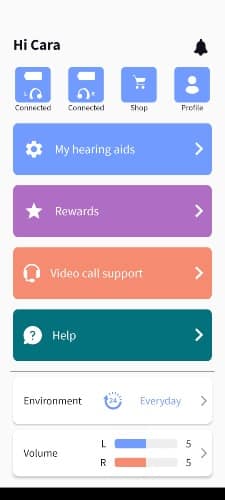
Lexie accessories
The Lumen and B1 come with four packages of size 312 disposable batteries as well as extra tips, so you can find the ones that fit the best. The B2 Plus also comes with four sizes of domes: three pairs of closed domes and one pair of open domes.
Hearing instrument specialists noted that dome style and size can affect not only the comfort of your hearing aids, but also sound quality and the amount of feedback you hear. The Lexie manual does a nice job of explaining when you should try a different size or style of dome. Still, if you can’t get a good fit or feel you’re not hearing as well as you’d like with the hearing aids, contact the Lexie customer support department for a video or phone call to get help from a hearing specialist.
As noted above, Lexie sells a Companion Mic to help you hear conversations better in loud environments. You can also purchase extra tubes, domes, batteries, and cases on the website or through the app.
To help extend the life of your hearing aids and protect them from moisture, Lexie sells an electronic hearing aid dryer for $69. It uses a combination of warm air and UV light to dehumidify and disinfect your devices. Keep in mind that to apply Lexie Rewards points to your purchases, they must be made through the app.
Lexie customer service and satisfaction
Customer service
- Phone: 779-212-7334, 9 a.m. to 8 p.m. ET, Monday through Saturday
- Email: support@lexiehearing.com
- Online contact form
Lexie is accredited with the Better Business Bureau (BBB) and has a customer rating of 3.54 out of 5 stars. The company’s TrustPilot rating is not as good, at 3.1 out of 5 stars. That rating is based on only ten reviews, though. Negative comments point out problems syncing the hearing aids to a smartphone and the batteries dying quickly.
Trial period, warranty, and care
Trial period
Most states require a minimum 30-day trial period for customers to get used to their new hearing aids and return them if they’re not a good fit, according to the HLAA.6 But Lexie goes one step further and gives you 45 days to test them. Get as much support from the company’s team as needed, and make sure they’re meeting your needs before making a commitment.
Warranty
Lexie hearing aids come with a standard one-year warranty covering manufacturer defects. You can also purchase the protection plan, which will add coverage for breakage or other damage.
Table 2 Protection plan costs by model, as of 2025
How to clean
To clean your Lexie Lumen hearing aids, thread the thin wire (included with your purchase) through the silicone tube. Then use the small brush that’s included to clean any wax off the dome. Use a soft cloth to wipe the body of your hearing aids, and they’ll be ready to wear again.
The B1 and B2 Plus hearing aids simply need to be wiped off daily with a dry cloth. Use the included brush to clean the domes, and then place them in the charging case each night. The rechargeable B2 Plus model also has wax guards beneath the domes to protect the inner parts of the device from ear wax. The manual states that these need to be changed every three months, and you’ll receive a small tool to help with this task in the box with your hearing aids.
How to store
The user manuals for the Lumen and B1 say to store your hearing aids with the battery door at least halfway open. This will preserve battery life by turning the hearing aids off, and it will also allow moisture to escape.
Lexie Lumen and B1 hearing aids come with drying capsules that can also be used to remove moisture from your hearing aids, prolonging their life. Place your hearing aids and one drying capsule in an airtight container overnight or when not in use. The manual says that one capsule should last between one and three months. You can order more capsules on the Lexie website or through the app.
The B2 Plus hearing aids should be stored in the closed charging case and plugged into an outlet when you’re not wearing them. The website states that storing them in an unplugged charging case can cause the batteries to die.
Water resistance
Lexie devices have a water-resistant coating, but they aren’t waterproof. You’ll need to remember to take them out before showering, swimming, or doing outside activities that could cause them to get wet.
If you want a hearing aid that won’t be damaged by water, Jabra Enhance and Eargo make water-resistant hearing aids. But while they can withstand rain, sweat, and most likely the shower if you forget to remove them, they should not be submerged. The prescription brand Phonak also makes a waterproof hearing aid called the Lumity Life, which can be submerged in water up to half a meter.
How to return
Lexie accepts returns within 45 days of purchasing hearing aids, but you will have to pay the shipping fees to mail them back to the company.
Who Lexie hearing aids are for
Lexie could be a great choice for some people’s hearing and lifestyle needs, but it may not be the ideal hearing aid for everyone. Lexie devices, like all OTC hearing aids, are meant for adults 18 and older with mild to moderate hearing loss. We also think they’re the best fit for someone who is comfortable with technology, as they’re designed to be used with the Lexie Hearing app to get the full benefit.
If you’re new to hearing aids, the Lumen may be your best choice. The hearing aids automatically adjust based on the results of the hearing test you take when you first get them. From that point on, you can use the buttons on the hearing aids or the app to select a listening profile and change the volume.
It might take a few tries to successfully make the fine-tuning adjustments needed to achieve the correct profile for the B1 and B2 Plus. Lexie offers remote support if you need help.
Although Lexie is considered a budget-friendly OTC hearing aid, the company makes high-quality hearing aids with a nice range of options and knowledgeable customer support.
Table 3 Comparing Lexie to other brands, as of 2025
| Cost per pair | Type of hearing aids | Types of hearing loss | Learn more | |
|---|---|---|---|---|
| $799–$999 | BTE, RIC | Mild to moderate | Visit Site | |
| $799–$1,995 | RIC | Mild to moderately severe | Visit Site | |
| $2,600–$6,500 | BTE, RIC, ITE, CIC, IIC | Mild to profound | Visit Site | |
| $799–$2,950 | CIC | Mild to moderate | Visit Site | |
| $299–$699 | BTE, ITE | Mild to moderately severe | Visit Site | |
|
|
$2,800–$7,500 | BTE, RIC, ITE, CIC, IIC | Mild to profound | |
| $1,998–$4,598 | BTE, RIC, ITE, CIC, IIC | Mild to profound | Visit Site |
For more information on each of these brands and details about different types of hearing aids, read our review of the best hearing aids of 2025.
What to consider before buying hearing aids
Degree of hearing loss
The first factor to consider before buying any hearing aid is your degree of hearing loss as determined by an in-person hearing exam. If you are an adult and have been diagnosed with mild to moderate hearing loss, you may be a great candidate for an OTC hearing aid like Lexie.
Bluetooth use
As we’ve mentioned above, all Lexie devices connect to the Lexie Hearing app with Bluetooth for making adjustments and contacting customer service. You can’t stream music or movies through these hearing aids, but you can stream phone calls from an iPhone with the B2 Plus model.
Your comfort level with technology
All Lexie models are designed to be used with the app, which allows you to adjust the volume and listening settings, shop for accessories, and contact the hearing specialist team for remote support with your hearing aids. The Lumen has buttons for adjustments, and the volume on the B1 and B2 Plus can be changed with a button as well, but you won’t get the full use of these hearing aids without the app.
For instance, you won’t be able to take the initial hearing test on the Lumen app, which means you’ll lose out on the automatic hearing profile adjustment. You also won’t be able to do any fine-tuning on the B1 or B2 Plus without the app.
If you’re more comfortable with a hearing aid that doesn’t require an app to access all of its features, we recommend one of two other types of hearing aids. You could choose a simpler (and less expensive) OTC hearing aid that doesn’t come with an app at all, such as some models offered by MDHearing or Audicus. Keep in mind that these hearing aids, like the Lexie Lumen, most often come with only a few preset listening profiles, which may or may not meet your hearing needs, based on the listening environments you’re often in.
If you are frequently in places that make it hard to hear and understand conversations, such as loud restaurants or theaters, crowded places, sports events, or areas with loud equipment, a prescription hearing aid may be a better fit for you. Even if you have mild or moderate hearing loss, your lifestyle and daily routine could mean you’ll be happier with a prescription device, because they can be programmed more precisely for different listening environments.
Brands like Phonak, Widex, ReSound, Signia, Starkey, and Oticon provide a wide range of hearing aids to address all levels of hearing loss, from mild to profound. These hearing aids are generally more expensive than OTC brands, but they can also address more complex listening needs and hearing loss profiles. And you’ll be getting the benefit of in-person support whenever you need it.
While all prescription hearing aids do come with an app if you’d like to use it, they’re designed to be programmed (also called being “fitted”) by an audiologist or hearing instrument specialist in the clinic so you don’t need to make many adjustments at home. Prescription hearing aids have buttons for volume and setting changes, but hearing specialists say that needing to constantly adjust your hearing aid is a sign it isn’t programmed correctly. If this sounds familiar, call your hearing specialist for an adjustment.
How to buy Lexie hearing aids
Lexie Hearing sells devices directly from its website as well as through third-party retailers like Amazon, Best Buy, CVS, Walgreens, and Walmart.
To buy hearing aids through the Lexie Hearing website, follow these steps:
- From the home page, click on “OTC Hearing Aids” and choose the model you want to purchase.
- Select either the one-time payment or the financing option through Klarna.
- Add the care kit plan or protection plan if desired with the one-time payment.
- Click “Add to Cart.”
- Click “Proceed to Checkout” to fill in your payment and shipping details.
Lexie hearing aids near me
If you purchase your hearing aids through the Lexie website, you’ll get free shipping. You can also send any questions or concerns directly to the company through the online contact form. Contacting Lexie online or by phone is the best way to get in touch with a hearing specialist for any questions related to your hearing aids or hearing health.
Lexie hearing aids are also available at the following stores that carry health care devices:
Lexie hearing aid customer reviews
“I have learned and reached new goals. Totally happy with my new ears. Can wear them for hours with no effort now.”
Jerry P, VERIFIED CUSTOMER REVIEW (BBB.ORG)
“I was never able to use the hearing aids because they failed immediately. After two weeks of phone calls to very poor customer service, I was told the only thing they will do is send me new ones but not until I return the old ones. And shipping to me was going to be 4-6 business days. But when I ordered I paid for two day shipping. They gave me the run around for two weeks and dragged me along and didn’t do anything for me. I can’t attest to the quality of the hearing aids because I never got to use them.”
John M, VERIFIED CUSTOMER REVIEW (BBB.ORG)
“Lexie hearing aids are the best I’ve ever had. I can hear better now, things I haven’t heard in many years. TV is enjoyable now!”
Carolyn, VERIFIED CUSTOMER REVIEW (TRUSTPILOT.ORG)
Bottom line
Lexie Hearing produces high-quality OTC hearing aids for adults 18 and older with mild to moderate hearing loss, in a price range that’s less than half what some other OTC brands cost. The biggest limitations of this brand in terms of technology are that only the B2 Plus model offers Bluetooth streaming for iPhone phone calls (not music or TV streaming), and the sound processing capabilities are lower than those you’ll find in a prescription hearing aid.
If you’re often in challenging listening environments or have more complex listening needs, you may be more successful with a prescription device bought through a hearing specialist. But if your hearing loss is mild or moderate and you’re comfortable with remote hearing support, Lexie is a brand worth trying. You’ll have 45 days to wear them and see how they work for you. Don’t forget to take advantage of the company’s free audiology support to get the most out of your new hearing aids.
Frequently asked questions
Lexie is a reputable company that makes quality hearing aids and provides reliable customer support. Compared to other OTC brands, our team found that Lexie devices offered good sound quality, superior durability, and a better range of features than most. Every time we contacted customer support by calling or using the online chat, we were able to get our questions answered.
You can purchase Lexie hearing aids online and in several nationwide retail chains where health care devices are sold. These stores include Best Buy, CVS, Walgreens, and Walmart. But be aware that employees at these retail locations are neither audiologists nor hearing care specialists, so they are not certified to dispense hearing aids like a professional from a hearing clinic. Yet they can still answer general questions for you. For in-depth medical advice, experts advise you to see a professional in person at a hearing clinic.
Like most hearing aids, you can expect Lexie devices to last about five years before they need to be replaced.
Lexie is a true hearing aid, not a personal sound amplification product (PSAP).7 While hearing aids can be adjusted to meet your specific listening needs by amplifying some sounds more than others and are programmed for specific hearing profiles, most PSAPs amplify all sounds. They can even cause hearing loss if turned up too high or worn for too long. And hearing aids are regulated by the FDA as medical devices, whereas PSAPs are sold as consumer electronics and don’t have to meet FDA requirements for sale.
Lexie hearing aids are regulated by the FDA according to its OTC hearing aid guidelines. [8] U.S. Food and Drug Administration. FDA Finalizes Historic Rule Enabling Access to Over-the-Counter Hearing Aids for Millions of Americans. August 16, 2022. Found on the internet at https://www.fda.gov/medical-devices/hearing-aids/otc-hearing-aids-what-you-should-know The B1 and B2 models have also received FDA clearance as self-fitting hearing aids.
Lexie hearing aids are made by hearX, a company based in Pretoria, South Africa. HearX also manufactures audio software and Go Hearing OTC hearing aids.
Have questions about this review? Email us at reviewsteam@ncoa.org.
Sources:
- Johns Hopkins University. The Hidden Risks of Hearing Loss. Found on the internet at https://www.hopkinsmedicine.org/health/wellness-and-prevention/the-hidden-risks-of-hearing-loss
- Federal Register. Medical Devices; Ear, Nose, and Throat Devices; Establishing Over-the-Counter Hearing Aids. August 17, 2022. Found on the internet at https://www.federalregister.gov/documents/2022/08/17/2022-17230/medical-devices-ear-nose-and-throat-devices-establishing-over-the-counter-hearing-aids
- Hearing Loss Association of America. Are You Hearing Everything You Could? Found on the internet at https://www.hearingloss.org/wp-content/uploads/HLAA_HAT_and_Telecoil.pdf
- Code of Federal Regulations. Self-Fitting Air-Conduction Hearing Aid. Found on the internet at https://www.ecfr.gov/current/title-21/chapter-I/subchapter-H/part-874/subpart-D/section-874.3325
- HHS.gov. What Is Medicare Part C? Found on the internet at https://www.hhs.gov/answers/medicare-and-medicaid/what-is-medicare-part-c/index.html
- Hearing Loss Association of America. Consumer Protection Laws. May 2013. Found on the internet at https://www.hearingloss.org/wp-content/uploads/ConsumerProtectionLaws.pdf
- U.S. Food and Drug Administration. Hearing Aids and Personal Sound Amplification Products: What to Know. Found on the internet at https://www.fda.gov/consumers/consumer-updates/hearing-aids-and-personal-sound-amplification-products-what-know
- U.S. Food and Drug Administration. FDA Finalizes Historic Rule Enabling Access to Over-the-Counter Hearing Aids for Millions of Americans. August 16, 2022. Found on the internet at https://www.fda.gov/medical-devices/hearing-aids/otc-hearing-aids-what-you-should-know




